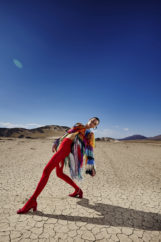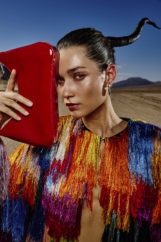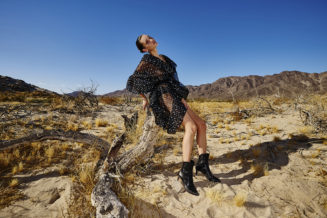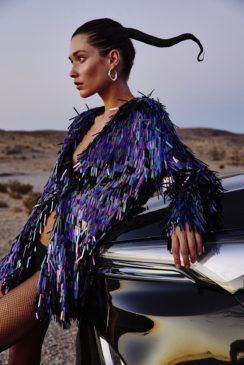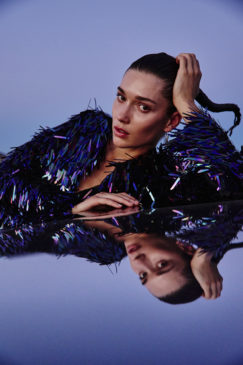All photos by Sonnyphotos
Dear Shaded Viewers,
Founded in 2001 by Johnson Hartig, Libertine is a Los Angeles-based fashion brand that has consistently defied convention with its bold aesthetic and commitment to individuality. From its origins in repurposed vintage clothing to its current status as a purveyor of luxury designs, Libertine has evolved while maintaining its core values: creativity, sustainability, and a fearless approach to self-expression.
Hartig’s background in art—not fashion—has proven to be one of the brand’s greatest strengths. His artistic sensibility allows him to approach design with an abstract, free-spirited mindset. “If you’re a curious person, everything influences everything,” Hartig says, reflecting on his creative process. Whether drawing inspiration from exotic travel destinations like India and Uzbekistan or immersing himself in art, Hartig’s collections emerge organically rather than following trends or linear patterns.
When Libertine first launched, it focused exclusively on recycled vintage clothing—a reflection of Hartig’s upbringing during the punk and new wave eras of Los Angeles. “We were all in every vintage and thrift store all over everywhere,” he recalls. “I can’t think of another era that was more DIY and based on creativity and self-expression.”
However, after nearly a decade, the rise of fast fashion made quality vintage pieces scarce. This prompted a pivotal shift: Libertine began producing original garments in small quantities using high-quality materials like Italian fabrics, wools, tweeds, and linens. Designing fabrics became one of Hartig’s favorite aspects of the process, opening up new creative avenues while maintaining the brand’s commitment to craftsmanship.
“We’ve gone from exclusively recycled vintage to absolutely creating everything—but again in very small quantities,” Hartig explains. All Libertine pieces are made in America, an uncommon feat in the luxury fashion industry that underscores the brand’s dedication to sustainability and ethical production.
Collaboration has been integral to Libertine’s identity, particularly its creative exchange with renowned artist Damien Hirst. Their partnership began when Hirst purchased Libertine pieces and reached out to express his admiration for the brand. Over six years, they traded clothing for artwork and collaborated on projects benefiting causes they both cared about—such as paying off medical bills for an animal rescue organization close to Hartig’s heart.
“I love working towards a specific purpose,” Hartig says of collaborations like these. While he is selective about partnerships, he embraces opportunities that align with Libertine’s ethos. From working with Target to designing home fabrics and wallpapers for Schumacher, Hartig finds joy in exploring new mediums while staying true to his artistic vision.
For Hartig, innovation is rooted in curiosity rather than conformity. “I always have ideas—I’m a real idea person,” he says. Whether designing for Libertine or creating something for his home or garden, Hartig views creativity as an endless journey fueled by his interest in everything around him.
This approach has allowed Libertine to remain authentic despite the ever-changing fashion landscape—a landscape Hartig critiques for its reliance on bloggers and influencers. “I think bloggers and influencers messed the whole system up,” he says bluntly. “What are these people’s credentials? It’s all so messed up.” Despite these challenges, Libertine has thrived by staying true to its values and focusing on quality over hype.
Libertine embodies the principles of slow fashion through its small-scale production methods and commitment to giving back. All garments are made domestically in limited quantities—a rarity in today’s fast-paced industry. Additionally, Hartig has developed programs that invite underserved children into Libertine’s studio for educational visits, aiming to inspire future generations through creativity and passion.
“Being conscious in life is as important—or more important—than being conscious in your career,” Hartig observes. For him, sustainability is not just about design but about living thoughtfully.
Reflecting on Libertine’s 24-year journey, Hartig marvels at the brand’s longevity: “We’ve been profitable since day one without outside investment.” However, he is candid about the difficulties of succeeding in today’s fashion industry: “It’s an incredibly difficult business to have any success in.”
His advice for aspiring designers is refreshingly honest: “Don’t do it.” While this may sound discouraging, it underscores the challenges of navigating an industry that has become increasingly disconnected from its roots.
Despite being based in Los Angeles, Hartig finds little inspiration from the city itself: “Los Angeles is one of the least inspiring cities I’ve ever been in.” Instead, he seeks creative fuel from exotic locales like Morocco, Petra in Jordan, Egypt, and Uzbekistan—places rich with history and culture that resonate deeply with his artistic sensibilities.
Through its fearless designs and unwavering dedication to individuality, Libertine continues to inspire both within the fashion world and beyond it. As Hartig reflects on his journey—one marked by creativity, consciousness, and resilience—Libertine’s approach to fashion is a testament to staying true to one’s vision against all odds.
Photo Credits
Golden Brown by Libertine
Photos Sonny Vandevelde
Styling Nikki Ewanouski
Model Renée Wilks @Ford Models
Hair The Team
Make Up Renée Wilks
Location Road Trip out of Los Angeles

